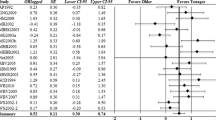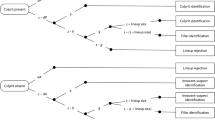Abstract
This article makes two major points in regard to expert psychological testimony on eyewitness identification. First, the attention devoted by psychologists to eyewitness identification issues is far out of proportion to the incidence of trials involving eyewitness identifications of criminal defendants; furthermore, the often-expressed concern over wrongful convictions is probably misplaced. Second, the experimental methods used in studies of eyewitness performance are fundamentally unsuited for drawing conclusions about actual witnesses. Hence, there is not an adequate scientific foundation for expert psychological testimony on eyewitness identification. Archival research is perhaps the most promising approach to the study of the criminal justice system.
Similar content being viewed by others
References
Clifford, B. R. (1979). Eyewitness testimony: The bridging of a credibility gap. In D. Farrington & P. Hawkins (Eds.),Psychology, law and legal processes. London: MacMillan.
Ebbesen, E. B., & Konečni, V. J. (1980). On the external validity of decision-making research: What do we know about decisions in the real world? In T. S. Wallsten (Ed.),Cognitive processes in choice and decision behavior. Hillsdale, New Jersey: Lawrence Erlbaum.
Ebbesen, E. B., & Konečni, V. J. (1982). Social psychology and the law: A decision-making approach to the criminal justice system. In V. J. Konečni & E. B. Ebbesen (Eds.),The criminal justice system: A social-psychological analysis. San Francisco: W. H. Freeman.
Greenberg, M. S., Wilson, C. E., & Mills, M. K. (1982). The victim's decision to report the crime. In V. J. Konečni & E. B. Ebbesen (Eds.),The criminal justice system: A social-psychological analysis. San Francisco: W. H. Freeman.
Konečni, V. J., & Ebbesen, E. B. (1982a). An analysis of the sentencing system. In V. J. Konečni & E. B. Ebbesen (Eds.).The criminal justice system: A social-psychological analysis. San Francisco: W. H. Freeman.
Konečni, V. J., & Ebbesen, E. B. (1982b). Social psychology and the law: The choice of research problems, settings, and methodology. In V. J. Konečni & E. B. Ebbesen (Eds.),The criminal justice system: A social-psychological analysis. San Francisco: W. H. Freeman.
Lindsay, R. C. L., & Wells, G. L. (1983). What do we really know about cross-race eyewitness identification? In S. Lloyd-Bostock and B. R. Clifford (Eds.),Evaluating witness evidence: Recent psychological research and new perspectives. Chichester, U.K.: Wiley.
Loftus, E. F. (1983a) Silence is not golden.American Psychologists, 38, 564–572.
Loftus, E. F. (1983b). Whose shadow is crooked?American Psychologist, 38, 576–577.
Loh, W. D. (1981). Psycholegal research: Past and present.Michigan Law Review, 79, 659–707.
Malpass, R. S. (1981). Training in face recognition. In. G. Davies, H. Ellis, J. Shepherd (Eds.),Perceiving and remembering faces. London: Academic Press.
Malpass, R. S., & Devine, P. G. (1980). Realism and eyewitness identification research.Law and Human Behavior, 4, 347–358.
McCloskey, M., & Egeth, H. E. (1983a). A time to speak, or a time to keep silence?American Psychologist, 38, 573–575.
McCloskey, M. & Egeth, H. E. (1983b). Eyewitness identification: What can a psychologist tell a jury?American Psychologist, 38, 550–563.
Olson, C. L. (1976). Some apparent violations of the representativeness heuristic in human judgment.Journal of Experimental Psychology: Human Perception and Performance, 2, 599–608.
Rembar, C. (1980).The law of the land: The evolution of our legal system. New York: Simon & Schuster.
Wells (1978). Applied eyewitness testimony research: System variables and estimator variables.Journal of Personality and Social Psychology, 36, 1546–1557.
Wilson, J. Q. (1983). Thinking about crime: The debate over deterrence.The Atlantic Monthly, September, 72–88.
Yarmey, A. D., & Jones, H. T. (1982). Police awareness of the fallibility of eyewitness identification.Canadian Police College Journal, 6, 113–124.
Yarmey, A. D., & Jones, H. P. T. (1983). Is the psychology of eyewitness identification a matter of common sense? In S. Lloyd-Bostock & B. R. Clifford (Eds.),Evaluating witness evidence: Recent psychological research and new perspectives. Chichester, U.K.: Wiley.
Author information
Authors and Affiliations
Additional information
Ebbe B. Ebbesen did not participate at the Johns Hopkins conference but has contributed to the written version of this paper. This is because the San Diego Psychology-Law Research Project, on which some of the comments in the paper are based, has been a collaborative effort from its inception in 1974.
About this article
Cite this article
Konečni, V.J., Ebbesen, E.B. Courtroom testimony by psychologists on eyewitness identification issues. Law Hum Behav 10, 117–126 (1986). https://doi.org/10.1007/BF01044563
Issue Date:
DOI: https://doi.org/10.1007/BF01044563




